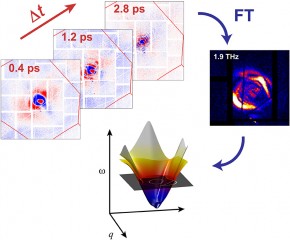X-ray Laser Used to Produce Movies of Atomic-Scale Motion

Image courtesy of SLAC National Accelerator Laborator A series of x-ray scattering images are taken at ultrafast time intervals (Δt) with an x-ray laser after excitation with an infra-red source that energizes the vibrational modes of a germanium crystal. The time domain images yield a vibrational intensity map (w) relative to the orientation and spacing (q) of the atomic crystalline array.
Atoms and the electrons that hold them together store energy in their electronic bonding structure and in their atomic vibrations. X-ray laser scattering techniques, which can record electron and atom motion at ultra-fast time scales, have been used to measure and track the transfer of energy from one atomic-scale storage mode to another.
The Impact
This x-ray scattering technique allows scientists to track the motion of atoms as they respond to sudden changes in their energy state. Tracking the mode of energy flow is critical to understanding the fundamental dynamics of energy conversion materials.
Summary
X-ray scattering can measure and describe the atomic positions in technologically important crystalline solids such as silicon and germanium. After an excitation by heat or radiation, the flow of energy can be tracked as it moves through various storage modes; such as atomic spacing and bonding, atomic vibrations, and electron or magnetic ordering. The new technique uses advances in synchronized infra-red and x-ray laser pulses along with a large area position sensitive x-ray detector, to make x-ray scattering movies that track the response of the material from the moment of excitation. Infra-red light excites electrons and the x-rays measure the vibrational wave length and frequency where electron charge distortions couple strongly to changes in the atomic vibrations. Short-lived transient states can be excited and measured and help determine how energy flows on atomic length scales. The time-domain measurements are a direct way to follow the excitations of solids and the flow of energy well away from their “home” positions and ground state.
Funding
Department of Energy, Office of Science, Basic Energy Sciences program, for both the research and the use of the Linac Coherent Light Source user facility at SLAC.
Publications
M. Trigo et al., “Fourier-transform inelastic X-ray scattering from time- and momentum-dependent phonon–phonon correlations.” Nature Physics 9, 790 (2013).
Contact Information
Kristin Manke
kristin.manke@science.doe.gov
Media Contact
More Information:
http://www.science.doe.govAll latest news from the category: Power and Electrical Engineering
This topic covers issues related to energy generation, conversion, transportation and consumption and how the industry is addressing the challenge of energy efficiency in general.
innovations-report provides in-depth and informative reports and articles on subjects ranging from wind energy, fuel cell technology, solar energy, geothermal energy, petroleum, gas, nuclear engineering, alternative energy and energy efficiency to fusion, hydrogen and superconductor technologies.
Newest articles

Properties of new materials for microchips
… can now be measured well. Reseachers of Delft University of Technology demonstrated measuring performance properties of ultrathin silicon membranes. Making ever smaller and more powerful chips requires new ultrathin…

Floating solar’s potential
… to support sustainable development by addressing climate, water, and energy goals holistically. A new study published this week in Nature Energy raises the potential for floating solar photovoltaics (FPV)…

Skyrmions move at record speeds
… a step towards the computing of the future. An international research team led by scientists from the CNRS1 has discovered that the magnetic nanobubbles2 known as skyrmions can be…





















